Taho is a Filipino breakfast treat made of soft or silken tofu, brown sugar syrup (arnibal) and sago or tapioca pearls. In addition to a very easy recipe, you’ll also get lots of tips and FAQs on how to make a perfect mug of this childhood favorite every time.
(Craving for more Filipino favourites? Try this champorado recipe. So good! And make tsokolate with your extra tablea while you’re at it.)

This taho recipe will transport you back to the Philippines — early mornings just before school, enjoying a warm mug of taho from your favorite taho vendor with his 2 large aluminum buckets slung over his shoulders.
Extra arnibal and sago for me, please.
Now you can find all kinds of flavors like strawberry, ube and pandan. They sell chilled taho and they’ve even come up with drinks and milk tea too.
But if you want to make taho like the one we grew up eating, this is the recipe for you. Every spoonful tastes exactly as we remember it.
Enjoy.
What is taho and what does it taste like

Taho is soft tofu with brown sugar syrup and sago. It’s traditionally eaten for breakfast but also enjoyed as a snack and even as a dessert.
It consists of:
- Soft tofu (also called silken tofu)
- Brown sugar syrup (arnibal, in Filipino)
- And sago or tapioca pearls
You then layer them in a cup or glass and enjoy with a spoon, similar to how you would eat a pudding.
The tofu, when eaten on its own, is bland. You add brown sugar syrup (others refer to this as the taho sauce) to sweeten, and sago pearls to give it texture.
How sweet or how much sago you put into your cup depends entirely up to you.
Why you’ll love this recipe
If you grew up eating taho like I did, you’ll love this homemade recipe because:
- It’s so easy to make.
- It tastes exactly like the one from home.
- And who knew tofu had so many health benefits? I just love it because it tasted good, now I know it’s good for me too.
Tools and ingredients
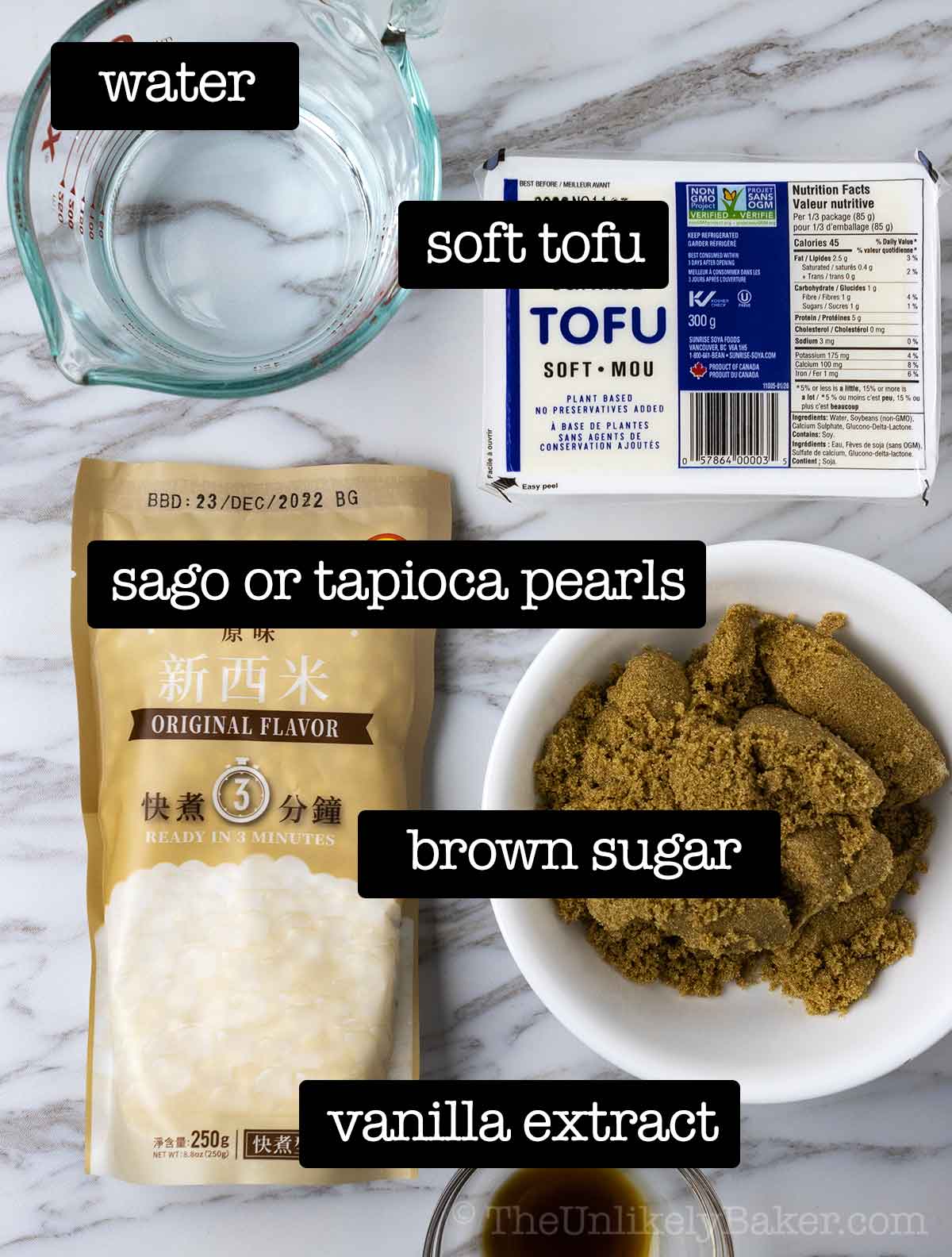
You’ll need just 5 ingredients to make taho at home, and that includes water! Some key things to remember:
- Soft or silken tofu — make sure you buy soft or silken tofu. Medium or firm tofu will not work in this recipe. It’s always clearly printed on the packaging. We usually find tofu in the chiller section of our supermarket.
- Sago or tapioca pearls — both will work so use what you have. See FAQs for more info. We buy them from the Asian supermarket but if you don’t have one near you, your local supermarket might have them in the baking section, or sometimes in the international aisle.
As far as cooking tools go, you would need a steamer or a steamer basket to cook the tofu.
Don’t worry if you don’t have one though. Here are DIY hacks you can try so you can steam the tofu without a steamer basket.
(Do you have extra-firm tofu? Make some air fryer tofu!)
Instructions
Taho has 3 components: the tofu, the taho sauce or simple syrup, and the sago.
To save time, you can cook the components at the same time, just make sure to watch each one because they have different cooking times.
Cooking them one at a time works, too.
How to steam the tofu
Silken tofu is very soft and can easily break apart so be careful removing it from the packaging. Drain the excess liquid before steaming.
- Place the whole block of tofu on a plate, or line your steamer with parchment or wax paper.
- Steam tofu for 10-15 minutes. Make sure your water is boiling before putting your tofu on the steamer.
- Remove and set aside.
Avoid over-steaming because this would make the tofu even more delicate. You just want it warmed and cooked all the way through.
How to make arnibal
Making arnibal or brown sugar syrup is just as easy and simple.
- Combine brown sugar and water in a saucepan and bring to a gentle boil until the sugar dissolves.
- Remove from heat, add vanilla extract (optional) and set aside.
Note that you don’t want this mixture reducing to a very thick syrup. It should still be easily pourable.
How to cook sago
How you cook sago depends on the kind you have.
I like the quick-cooking ones (it would say right on the package). Plus, those usually have English cooking instructions on the back.
If you can’t find those, you probably have the kind that needs about an hour to fully cook.
If you google how to cook sago, you’ll find 101 ways to do it. This is how I do it:
- Bring a big pot of water to a rolling boil. I don’t bother to measure how many cups of water; I just make sure it’s enough to fully cover the sago.
- Add the sago slowly and allow to simmer for 10 minutes. Stir occasionally so they don’t stick to one another.
- Switch off the stove and cover the pot.
- Wait another 10 minutes before draining the water and catching the sago in a mesh sieve.
- Rinse in cold running water for 15-20 seconds.
- Place them back in the pot, add water and cook on medium heat for 10 minutes.
- Repeat steps 3 to 6 until your sago is fully translucent and chewy but still al dente.
I’ve found that how long this process takes largely depends on the brand of sago or tapioca you have.
So I really make it a point to look for and buy the quick-cooking ones.
They taste the same and perfect for lazy cooks like me because all you’ll need is to follow the package instructions and they’re usually ready in 15 minutes or less.
How to assemble taho
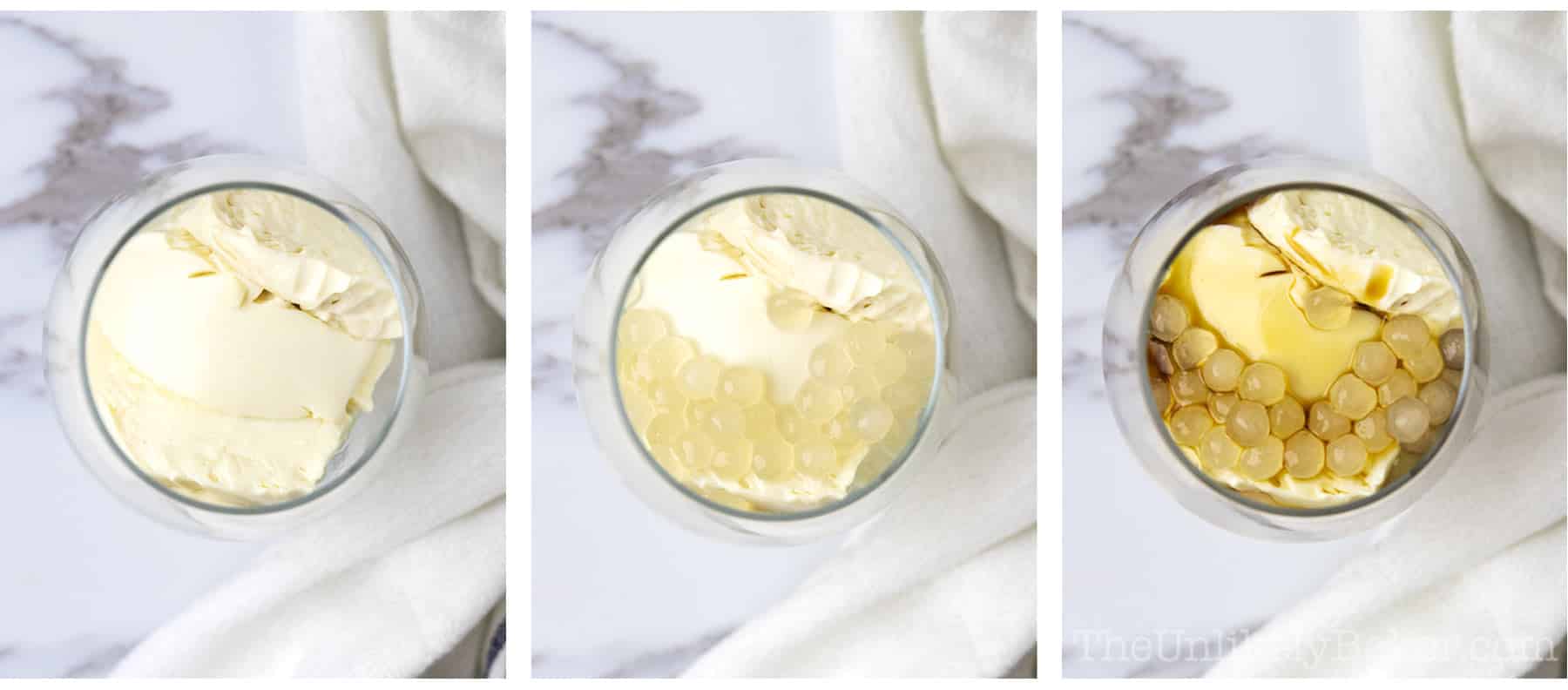
There’s really no science to taho assembly.
Traditionally, our vendor would smoothly scoop tofu from his tin container into our mugs, top it with sago, then pour arnibal.
You can put sago first if you like. Or you can layer tofu with sago.
And you can put as much or as little taho syrup as you want.
All up to you.
Expert tips

Easy, right? Here are more tips to make it even easier.
- Make sure to buy the right kind of tofu. Depending on where you are, this will be labeled soft tofu or silken tofu. Stay away from medium or hard tofu, which won’t work in this recipe.
- Use freshly cooked sago. Sago tends to get hard and rubbery the longer it sits. They’re best eaten the day they’re cooked but still okay to serve the next day.
- Serve warm. Taho is traditionally served warm. What you can do is assemble and serve as soon as your tofu is ready; or warm your taho for a few seconds in the microwave if the components have been chilled.
Recipe FAQs
If you’re wondering where this dish came from, you’ll find this article on the origin and history of taho very interesting.
It says the word “taho” comes from the Chinese word for the soft soybean pudding douhua and that it originated in China in the time of the Han Dynasty (206 to 220 A.D.). According to legend, it was accidentally discovered by a cook whose original intent was to make soy milk.
Check it out!
I explain in my mango sago recipe that even though sago and tapioca are used interchangeably, they are actually different things in that sago is an edible starch that is made from the pith of an array of tropical palm trees while tapioca pearls are made with tapioca or the starch from cassava, a root crop.
However, they look similar, taste similar, have a similar chewy texture when cooked, and cooked the same way. They’re often substitutes of each other in recipes too, though not always.
You can use either one for this recipe.
Soft tofu is the Chinese-style equivalent of silken tofu. While it’s slightly less smooth than silken tofu, the two are interchangeable and can be used and cooked the same way.
Taho and tofu are not the same things. Tofu is an ingredient in taho, the Filipino dessert.
Kept in the fridge, your components will last up to 3 days. You can most likely still eat it a few days after that but the sago tends to harden the longer it sits.
Assembled taho is best eaten immediately.
I don’t recommend freezing taho because it will drastically change the texture of the tofu and sago. It’s best kept in the fridge.
While taho is traditionally eaten warm or room temperature, you can certainly eat it cold or chilled. Just know that the sago will have a firmer bite to it when served cold.
After assembling, microwave the cup or glass it is in for 30 seconds to 1 minute or until it’s warmed all the way through.
Other Pinoy childhood favorites
Looking for other Filipino recipes from childhood? Try these recipes and enjoy the trip down memory lane.
Happy steaming!
Did you make this delicious Filipino treat? I’d love to hear all about it! Leave a comment or a star rating below. You can also tag me on Instagram or Facebook. I’d love to see your creations!
You can also find me on Pinterest, Twitter and YouTube.

Filipino Taho Recipe
Equipment
Ingredients
- 1 18-oz pack soft or silk tofu
- ½ cup sago or tapioca pearls
- 1 cup brown sugar
- ¾ cup water
- 1 tsp vanilla extract optional
Instructions
- Place your tofu in a steamer or steam basket and steam until fully cooked through, 10-15 minutes.
- While your tofu is steaming, you can work on your sago. This would depend on the kind of sago you have — some require almost an hour of cooking while others are done in 5 minutes. I provide more sago cooking tips in the post. Once your sago is done, put it aside in a bowl of cold water until you're ready to assemble.
- To make the arnibal, simply combine brown sugar with water in a saucepan and bring to a gentle boil until the sugar dissolves.
- Remove from heat and add 1 tsp vanilla extract, if using. Stir to combine. Set aside until you're ready to assemble.
- To make taho, put tofu, sago and syrup in a mug, glass or bowl and enjoy! How much of each you put depends entirely up to you.
Video
Notes
- The number of servings depend on how you layer/customize your taho.
- Careful not to reduce your arnibal to a very thick syrup. It should still be easily pourable.
- You can also prepare more sago or arnibal, adjust the quantities depending on how you like to take your taho.
Nutrition
Nutritional information are estimates only.


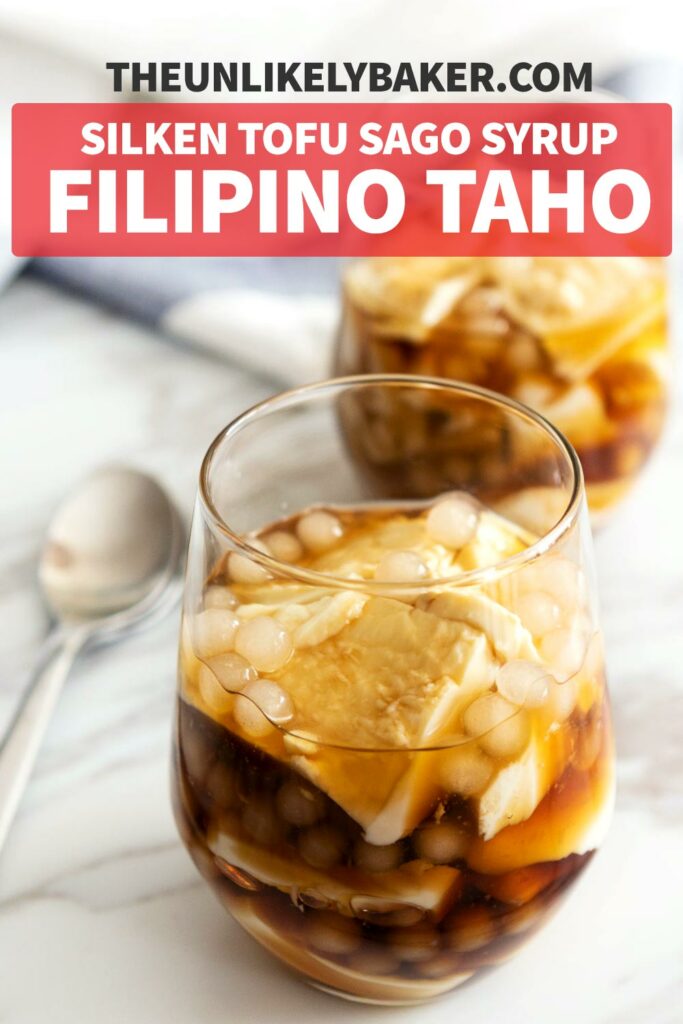

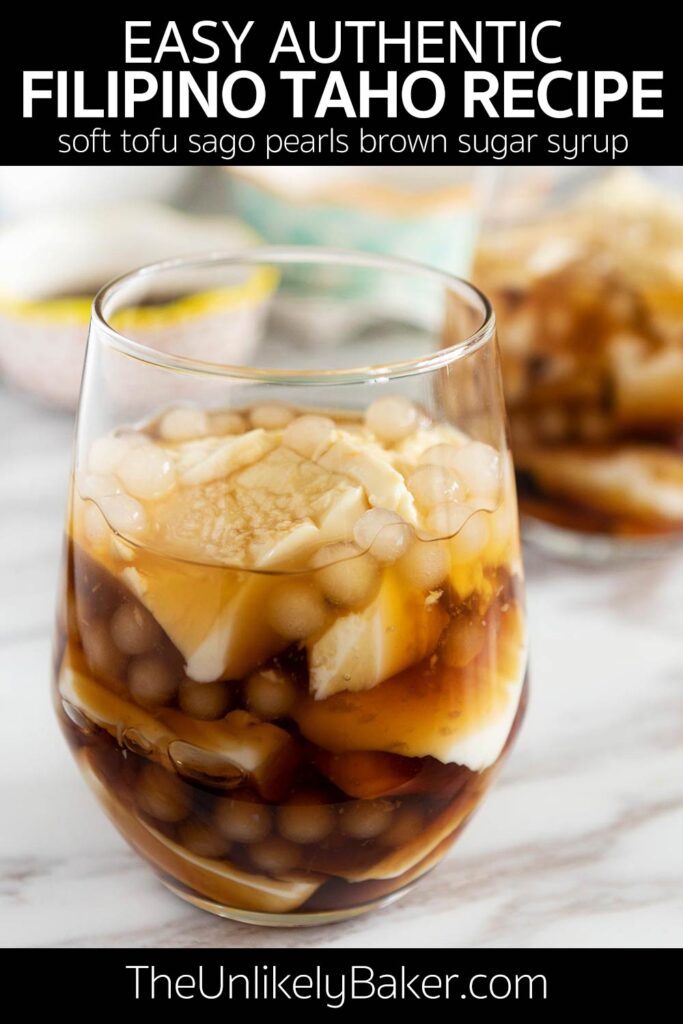
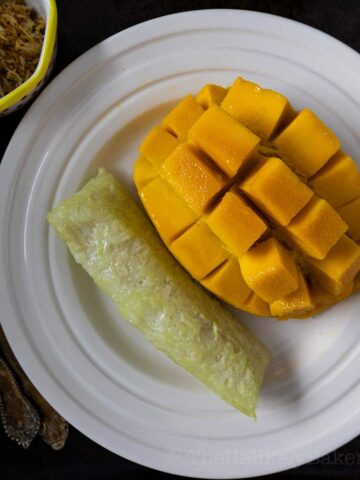







Amy Liu Dong
This is one of my favorites and it is really delicious!
Jolina
It’s one of our all-time favorites too )
Marge
We have so many happy memories with taho in the morning, like yours! Thanks Jolina for this nice trip down memory lane. Will definitely make some.
Jolina
Enjoy Marge! 🙂
Jamie
Oh my, as I have Filipino blood. This is my favorite treat from my childhood years even now! This taho recipe looks really good and yummy! I’ll definitely save this and make it for the family here in the US. Thanks for sharing this wonderful Taho recipe! Loved it!
Liz
This recipe sounds so unique and delicious! Definitely have to give it a try.